
* After months of seesaw fighting, the climax to the battle for Guadalcanal came in mid-November 1942, in running nights of savage naval battles, in which the Americans ended up dealing out more punishment than they took. The Japanese, unable to gain the initiative, finally had to concede defeat, and withdrew in early 1943.
* The Tokyo Express continued its runs to bring in Japanese troops and supplies by night. On 2 November, they also inserted a force of about 1,500 men onto Koli Point, east of Henderson field, which raised concerns in Washington DC. It made less of an impression to the leadership on Guadalcanal, with the Marines moving aggressively against the intruders, supported by naval firepower from destroyers and cruisers. By 9 November, there wasn't much left of the Japanese to the east of the airfield, though they remained in strength to the west.
The Marines were not idle against the Japanese there either, conducting a campaign west of the Matanikau River, moving through the thick jungle at great effort, with support from naval and ground artillery, as well as the Cactus Air Force. The IJA units confronting the Marines were finally forced to yield, though the Marines suffered themselves and finally bogged down. However, Marines of the 2nd Raider Battalion, operating deep in the jungle with the assistance of local guides, proved skillful at harassment: making a probe at the end of an IJA column, the Japanese being hit by a prepared ambush when they tried to counterattack, the Marines then disappearing into the jungle. They ended up killing hundreds of Japanese to losses of only a few dozen of themselves.
In the meantime, both sides continued to bring in reinforcements. The Army had brought in long-range 155-millimeter guns that could bring Japanese 150-millimeter guns under fire, effectively neutralizing them. The Army was also flying in twin-engine P-38 Lightning fighters, with performance superior to the formidable Mitsubishi Zero -- at least in the hands of a pilot who knew the relative strengths and weaknesses of the two aircraft, the Lightning being less maneuverable, but having a better rate of climb.
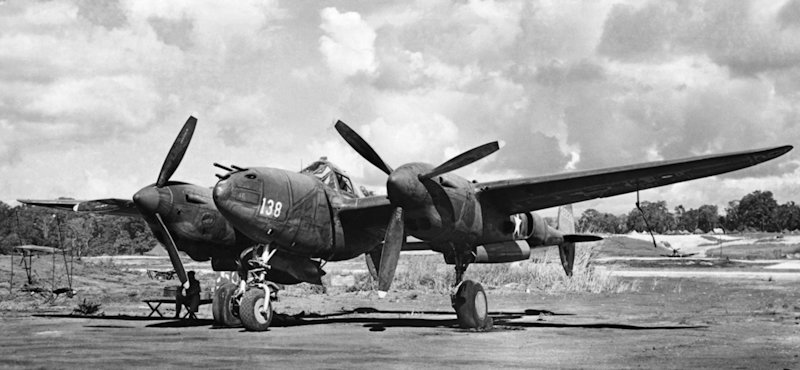
Naval skirmishing continued as well, with submarines torpedoing but not sinking two US Navy vessels; in response, the IJN submarine I-172 was sent to the bottom by the US Navy on 10 November. American forces were encouraged by the news of Operation TORCH, with US and British forces landing at multiple points in North Africa on 8 November, the exercise plagued by confusions but ultimately successful.
* In the wake of the Japanese failure to take Henderson Field, Colonel Tsuji sent a message to IJA high command in Tokyo, taking responsibility for the defeat. On 3 November, he was ordered back to Tokyo to report on the situation. General Kawaguchi left the island in disgrace the next day. Despite increasing doubts about the feasibility of holding Guadalcanal on the part of the IJN, the IJA still wanted to fight.
The conclusion was to get serious, with the IJN to neutralize Henderson Field and bring tens of thousands of troops to Guadalcanal along with their kit, so the Americans could be driven off the island once and for all. Had the Japanese taken such measures at the outset, there is little doubt they would have prevailed -- but the reality was that the Americans had become by that time a stronger and cannier opponent than they had been in August.
In the initial effort of the big push the IJA 38th Division's commander, Lieutenant General Satou Tadayoshi, arrived at Tassafaronga Point on 9 November with more of his men. They had been shipped down by five destroyers in the night, but the bulk of the division and its supplies were still at Shortland Island. The Japanese intended to bring the remainder down in 11 transports and cargo vessels, escorted by 12 destroyers. They were to be preceded by a naval raiding force, under the command of Vice Admiral Abe Hiroaki, consisting of two battleships, a light cruiser, and 14 destroyers, that would lay down fire on Henderson Field to ensure that the transports arrived safely.
The Japanese raiding force moved out of Rabaul on the morning of Thursday, 12 November, and by that afternoon was approaching Guadalcanal, then being spotted by US patrol aircraft. There was an Allied surface force in the area, Task Group 67.4, under the command of Rear Admiral Daniel J. Callahan, who had taken over command from Norman Scott. Callahan's group was operating in detached support of a new reinforcement convoy to Guadalcanal; his force consisted of two heavy cruisers, two light cruisers, and eight destroyers. Callahan led the group from the heavy cruiser SAN FRANCISCO. Admiral Scott served under Callahan in command of the light cruiser ATLANTA.
Japanese bombers escorted by fighters tried to interfere with the unloading of the American reinforcement convoy at Guadalcanal but was unable to do so, while suffering heavily from accurate anti-aircraft fire and the predations of Wildcats. The SAN FRANCISCO was hit by a Japanese bomber that crashed into the rear deck, injuring or killing dozens of sailors, but the damage was controllable. The convoy managed to unload by dusk and took off for the open sea, while Callahan's group looked for the Japanese raiders.
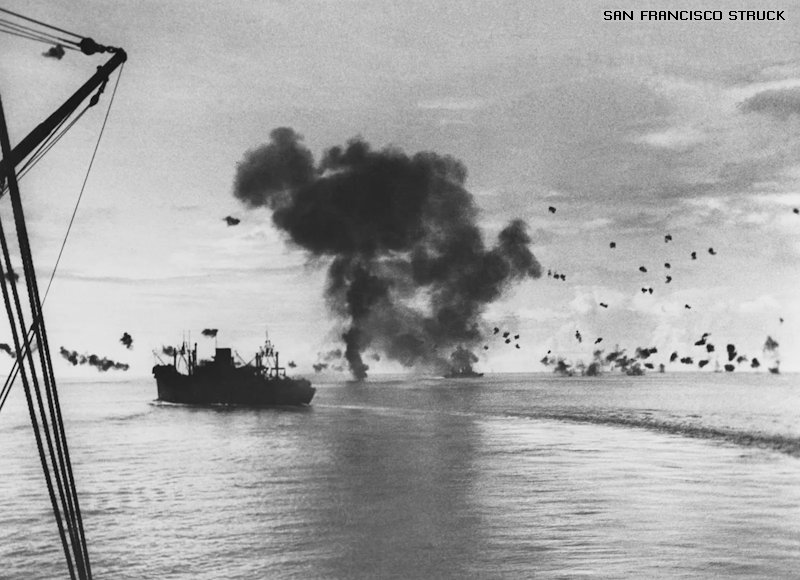
Abe knew he outgunned the Americans, and since the Americans had not demonstrated much aggressiveness at night, he did not think they would try to take him on. There is, as the saying goes, a first time for everything; Abe steamed on, unaware that he was heading for a confrontation. Bad weather complicated matters, hiding each force from the other and confusing their movements.
The light cruiser HELENA sighted the enemy at 0124 hours on Friday, the 13th of November. At 0149 the shooting started. The result was a mad, confused, brutal fight at close range in which warships of the two sides got mixed up among themselves, blasting away at each other and sometimes at their own vessels. One US Navy officer who participated in the clash compared it to "a bar-room brawl after the lights had been shot out."
The shooting lasted for a half hour. The US Navy took a beating, with the cruiser ATLANTA hit by torpedoes and by "friendly" shells. One shell hit the bridge, killing Admiral Scott and most of the bridge crew. ATLANTA eventually sank, along with four destroyers -- CUSHING, LAFFEY, BARTON, and MONSSEN. Only one of the American vessels hadn't been damaged; SAN FRANCISCO also took a hit in the bridge, killing Admiral Callahan and everyone else there.
The US Navy had not suffered passively. Two Japanese destroyers, AKATSUKI and YUDACHI, went down, while Abe's flagship HIEI took dozens of hits, unnerving the admiral; he did not go on to perform the bombardment of Henderson Field. The engagement became known as the "Battle of Friday the 13th". The shootout put on spectacular fireworks for the observers at Henderson Field. One Marine private with a literary bent wrote:
BEGIN_QUOTE:
The star shells rose, terrible and red. Giant tracers flashed across the night in orange arches ... the sea seemed a sheet of polished obsidian on which the warships seemed to have been dropped and been immobilized, centered amid concentric circles like shock waves that form around a stone dropped in mud.
END_QUOTE
The confrontation in the dark was only the beginning of the fight. Callahan had accepted combat at bad odds and at the cost of his own life to slow down the Japanese, and had succeeded in doing so. The IJN bombardment force having been diverted from its mission, Henderson Field was intact when the sun came up that Friday morning, and American fliers went out looking for blood. They caught up with the limping HIEI and pounded her with bombs and torpedoes; the battleship went down during the day, becoming the first IJN battleship to be sunk by the Allies. As a consequence, Admiral Abe was relieved of command.
However, the Japanese were demonstrating their customary aggressiveness as well. When the five surviving warships of Task Group 67.4 left for the New Hebrides to tend to their wounds late in the morning of 13 November, the IJN submarine I-26 --which had earlier put the carrier SARATOGA out of action for the interim -- tried to torpedo the SAN FRANCISCO. The torpedoes missed that vessel, but one hit the light cruiser JUNEAU, setting off a massive explosion that simply blew her to bits. Captain Gilbert Hoover on the HELENA, in charge of the force, decided there were no survivors and, worried about further torpedo attacks, simply departed, leaving scores of men floundering in the water, only a few being rescued after days of fumbling and delay. Almost the entire crew of the JUNEAU, some 700 men, died, including the five Sullivan brothers. After that, the US Navy never assigned more than one family member to a single ship.
BACK_TO_TOP* The Japanese were still determined to get the troop convoy to Guadalcanal, and on the evening of Friday the 13th, they went in to try again, with cruisers and destroyers shelling Henderson Field for 37 minutes. The pounding was severe and there was much worry back in Washington DC. The Americans on Guadalcanal were feeling discouraged, but not defeated; although 18 aircraft were destroyed in the bombardment, the Cactus Air Force remained in business when the sun came up on Saturday, 14 November.
The American fliers quickly found the troop convoy, under command of the ever-persistent Rear Admiral Tanaka, who continued towards Guadalcanal though air attacks that continued all day. Destroyers laid down smoke screens, but by the time the day was over, six of the transports had gone to the bottom and one was disabled, to ultimately sink. Tanaka put survivors on escorting destroyers and sent them back to Shortland Island. US aircraft also damaged a number of IJN warships and sent the heavy cruiser KINUGASA to the bottom. Things weren't looking so bad for the Americans after all.
The battle was still not over; four transports and four destroyers steamed on. Yamamoto was backing up the effort to the maximum, ordering Admiral Kondou down the Slot to hit Henderson Field once more that night with the battleship KIRISHIMA, two heavy cruisers, two light cruisers, and escorts of destroyers.
Halsey was just as stubborn, and ordered Task Force 64 under Rear Admiral Willis "Ching" Lee to meet the Japanese. Task Force 64 included the battleships WASHINGTON and SOUTH DAKOTA, plus four destroyers. The ships had been protecting Halsey's only carrier in the area, the ENTERPRISE, but now they were looking for a fight. They swung around Cape Esperance that night, and at about 2252 hours on 14 November made radar contact with Kondou's lead vessel, the light cruiser SENDAI. Lee waited until about 2320 to begin his attack. Both sides went into combat energetically.
In a short time, all four of Lee's destroyers were out of action -- WALKE and PRESTON both sinking; BENHAM so mangled that she had to be sent down by American naval gunfire the next afternoon; GWIN taking a beating but surviving. The SOUTH DAKOTA had been pounded by the KIRISHIMA and the two heavy cruisers. The American battleship was heavily armored, and though the hits were painful, given competent damage control none of them were close to fatal; Kondou had been expecting to perform a bombardment, not get into a shoot-out, and so his warships were firing high explosive instead of armor-piercing shells. However, the pummeled American battleship's electrical system had been knocked out, and its radars were out of operation. Blind, the SOUTH DAKOTA was out of the fight.
The Japanese remained focused on the SOUTH DAKOTA, attempting to send the warship to the bottom. They overlooked the WASHINGTON; Ching Lee, being unsure of where the SOUTH DAKOTA was, held fire until Japanese searchlights and star shells illuminated the SOUTH DAKOTA, ending his uncertainty. The WASHINGTON's salvos then bracketed the KIRISHIMA, quickly getting the range. Nine 410-millimeter (16-inch) and 40 127-millimeter (5-inch) shells smashed into the Japanese battleship, wrecking it.
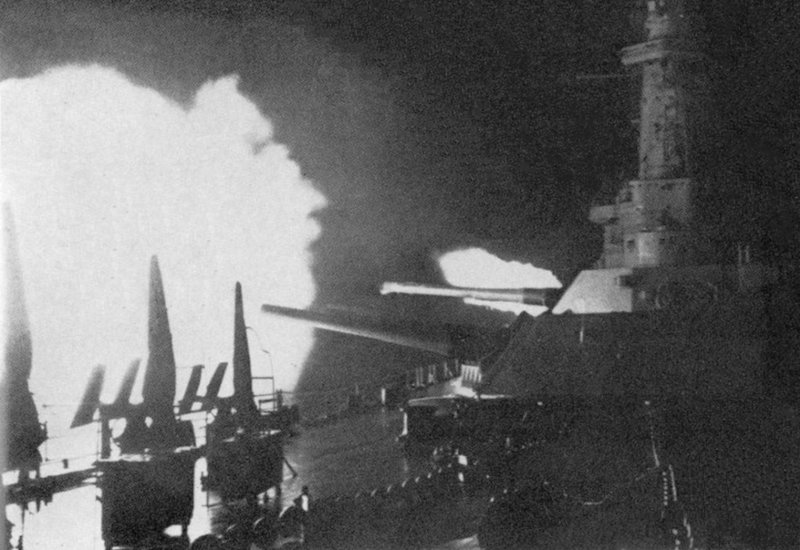
At 0025 hours on Sunday, 15 November, Kondou -- his force completely disorganized by the fight, and the admiral not knowing what the US Navy might throw at him next -- decided he'd had enough and withdrew, leaving behind the stricken KIRISHIMA and a disabled destroyer, the AYANAMI. The captain of the KIRISHIMA knew his vessel would suffer the same fate as the HIEI once it got light enough for American warplanes to pay a visit; rather than squandering the labors and lives of his men, he had them abandon ship onto a helpful destroyer, and then scuttled his vessel. The AYANAMI was also scuttled.
The IJN had lost two battleships in the fighting since Friday, losses that made a strong impression on Japanese admirals. Lee had finally tipped the balance for the US Navy, having got the better of the IJN in a tough fight on a level playing field -- using his relatively expendable destroyers to effectively screen his battleships and then, with the WASHINGTON, hitting the Japanese with their guard down.
* Rear Admiral Tanaka had dispatched three of his destroyers to help Kondou. By the time the battle was over, he couldn't unload the four remaining transports by landing craft before the sun came up that Monday, so he asked permission to simply run them aground. Rabaul refused, but Kondou gave permission, and Tanaka ran the transports into the shore near Tassafaronga Point. By that time, it was getting light and the Cactus Air Force spotted the beached transports immediately, with ground and naval artillery adding their firepower -- the destroyer USS MEADE proving highly effective, dashing in aggressively and hammering everything within reach of its guns.
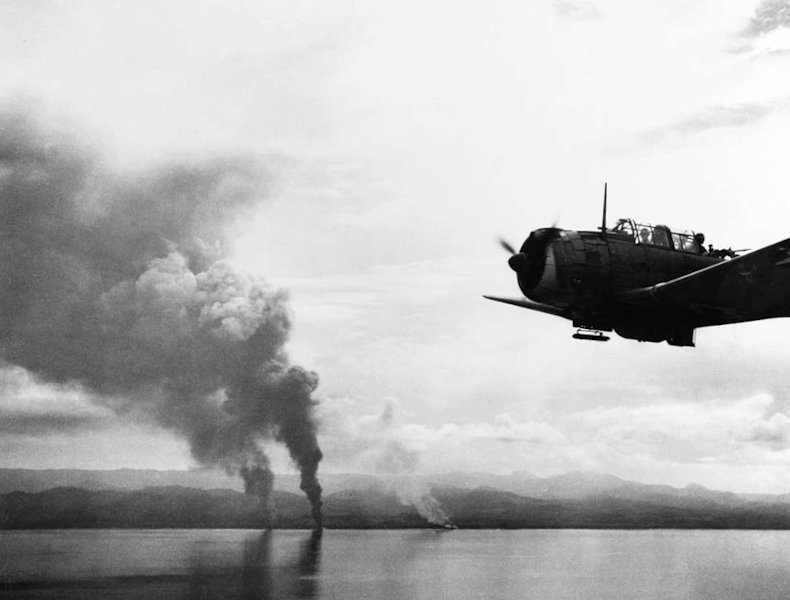
The shooting went on all through Monday, and the result was a ghastly slaughter of Japanese troops. For all the effort the Japanese had put into their "big push", in the end only a few thousand troops and a small load of supplies arrived on Guadalcanal -- at a cost to the IJN of the battleships HIEI and KIRISHIMA, the heavy cruiser KINUGASA, three destroyers, eleven transports, and a fair amount of damage to surviving vessels. The US Navy lost the light cruiser ATLANTA, the light cruiser JUNEAU, and seven destroyers, while seven other ships were damaged.
The US Navy had made serious mistakes and suffered heavily in the fifth sea fight for the island, the four-day "Naval Battle of Guadalcanal". American battle reports significantly exaggerated the damage done to the Japanese -- but the IJN had still been handed a stinging defeat with the loss of two capital ships, and more importantly in that the Americans had indisputably crushed the Japanese push to retake Guadalcanal. Vandegrift send a message to Halsey with grand praise for the Navy:
BEGIN_QUOTE:
WE BELIEVE THE ENEMY HAS SUFFERED A CRUSHING DEFEAT -- WE THANK LEE FOR HIS STURDY EFFORT OF LAST NIGHT ... OUR OWN AIRCRAFT HAS BEEN GRAND IN ITS RELENTLESS POUNDING OF THE FOE -- THOSE EFFORTS WE APPRECIATE BUT OUR GREATEST HOMAGE GOES TO SCOTT, CALLAGHAN AND THEIR MEN WHO WITH MAGNIFICENT COURAGE AGAINST SEEMINGLY HOPELESS ODDS DROVE BACK THE FIRST HOSTILE STROKE AND MADE SUCCESS POSSIBLE -- TO THEM THE MEN OF CACTUS LIFT THEIR BATTERED HELMETS IN ADMIRATION.
END_QUOTE
Back in Washington DC, Navy Secretary Frank Knox announced: "We can lick them. I don't qualify that."
A Navy after-action analysis of the battle was highly critical of Admiral Callahan's scatterbrained battle management, but the final result of the battle had been in American favor, and since he was dead, he was beyond reprimand; the inclination was to play him up as a hero. In fact, despite the bungles, the Americans had reason to be pleased with the outcome, all the more so because the war finally seemed to be tilting in favor of the Allies.
Rommel was on the run in North Africa, the Germans were being chewed up at Stalingrad. Everywhere, the Axis tide seemed to be going back out to sea. Indeed, later events would show that in mid-November 1942, the balance of the war in the Pacific had irreversibly tilted against Japan. Not only would the IJN no longer try to contest American control of Guadalcanal, but the Japanese had begun to think in terms of the defensive, a mindset that would only grow more entrenched over time.
The Americans, having been given effective ownership of the seas and skies of Guadalcanal, ramped up supply and reinforcement of the island. Henderson was now becoming a powerful forward air base -- in contrast to the shaky operation it had been, only kept alive by the hardest. Medium bombers were now operating from Henderson Field, performing raids on Japanese installations further up the Slot.
Growing US air power was increasingly able to operate effectively at night. Black-painted PBY Catalina flying boats -- the "Black Cats" -- performed aggressive strikes on Japanese shipping, and also supported attacks by the Cactus Air Force by dropping parachute flares to illuminate targets. IJN vessels were ever more at risk when they made runs down to the remote terminal of the Slot. They could only bring in supplies by fast destroyers or by submarines, and US Navy PT boats were also reaching their stride, becoming an affliction to the intruders.
The Japanese were still fighting, Marine actions against IJA forces along the Matanikau in the wake of the big sea fights bogging down in the face of stubborn resistance, but the Japanese had clearly lost the battle for Guadalcanal. They just hadn't admitted it yet.
BACK_TO_TOP* Back in Tokyo, the IJA high command was in denial, wanting to continue the fight, encouraged by the request of the Emperor himself to save the Japanese warriors on Guadalcanal. In the face of the Emperor's request, the IJN could not protest, but the admirals had no further heart for an operation they regarded as a lost cause. Japan was fighting a battle of attrition -- against an adversary with vastly more resources and who, after much stumbling, was clearly becoming more skilled at warfighting -- in an attempt to regain control of an outpost too remote from Japanese forward bases to be effectively supported.
The IJA high command was somewhat unsettled in their determination by reports from General Hyakutake on Guadalcanal that his men were dying of starvation and disease at a rate of about a hundred a day. The IJN was still trying to get some supplies to the starving men, but ever stronger American sea and air power was gradually choking off the supply line. The IJN was coming up with new schemes to help, such as a plan to load supplies in strings of oil drums hung on fast destroyers. The drums would be cut loose off of Guadalcanal, and motorboats or swimmers would pick them up.
The scheme was tested by Rear Admiral Tanaka, who took nine destroyers down the Slot to drop off supplies in this way on the evening of 29 November. While the destroyers were dropping their cargo just before 2300 hours, one of the warships reported sighting a column of American warships bearing down on them. There were five US Navy cruisers, escorted by six destroyers. The commander of the force, Rear Admiral Carleton H. Wright on board the MINNEAPOLIS, knew Tanaka's destroyers were there but hesitated much too long to attack. He finally gave the order at about 2320. The Americans launched torpedoes and started firing; they pounded the destroyer TAKANAMI, mortally wounding it.
By that time, it was too late, Tanaka's well-drilled sailors having loosed at least twenty torpedoes at their assailants. The American sailors on board the MINNEAPOLIS were cheering when the cruiser was hit by two torpedoes, with the cruiser's bow blown off. Another torpedo hit heavy cruiser NEW ORLEANS, setting off forward magazines and blowing off the front fifth of the vessel -- the separated bow spinning around and striking the cruiser towards the rear -- with yet another torpedo hitting the PENSACOLA and flooding its engine room, setting the warship alight like a torch. While the ships milled around in confusion, the NORTHAMPTON was hit by two torpedoes, which set off shattering secondary explosions. It was like knocking off ducks in a carnival shooting gallery.
The NORTHAMPTON quickly sank, most of its crew being rescued, while Tanaka's destroyers sped off in the dark -- failing in their mission to deliver supplies, but having painfully mauled the US Navy. The MINNEAPOLIS, NEW ORLEANS, and PENSACOLA survived; if the Americans had not shown much fighting skill in the clash, they at least proved competent in damage control. Lacking the resources at Tulagi to perform major repairs on large warships, the MINNEAPOLIS and NEW ORLEANS were patched up as best as possible with coconut logs, enabling them to get to Espiritu Santo for better repairs. All three cruisers, after full refit in home ports, were back in service by late 1943.
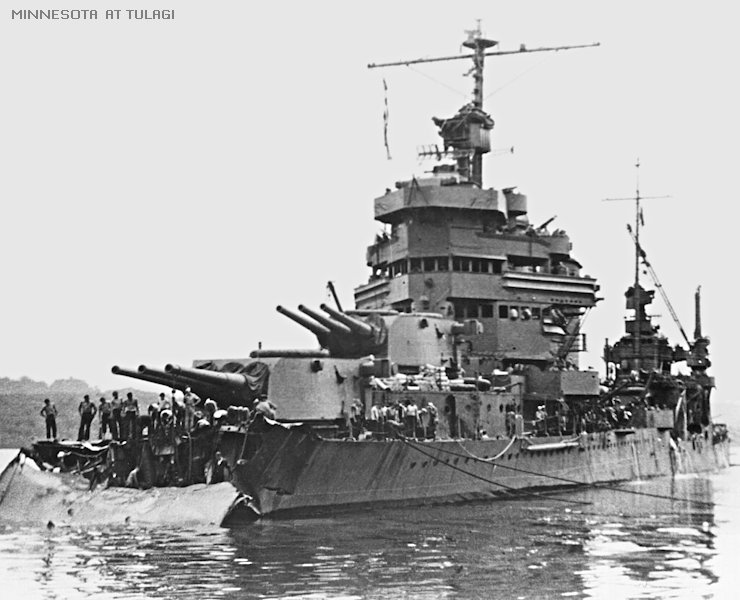
In the present, however, Tanaka had proven once again to the Americans that the Imperial Japanese Navy should not be underestimated, the IJN losing one destroyer while sinking an American cruiser and chewing up three others, even though the Japanese force was far weaker than its opponent. The sixth sea clash for Guadalcanal, the "Battle of Tassafaronga", was a lopsided victory for the Japanese, a Savo Island in smaller scale, the result being an embarrassment to the US Navy. Nimitz ordered training and more training; as far as he was concerned, it wasn't going to happen again.
BACK_TO_TOP* For the moment, the Japanese were still trying to hang on to Guadalcanal. They had been building an airstrip in a coconut plantation at Munda on the island of New Georgia, halfway up the Slot, ingeniously leaving treetops strung on cables as the trees were cut down in order to conceal the effort from Allied reconnaissance aircraft. The Munda airfield was ready for operation by early December. The Japanese had found it very difficult to put Henderson Field out of operation; now the Americans found out just how hard it was to destroy an airbase, bombing raids doing little to interfere with Japanese air operations there. A month later, the US Navy began to send in naval bombardment forces, which wouldn't have much better luck, Munda having become Japan's "unsinkable aircraft carrier".
Following the Battle of Tassafaronga, Rear Admiral Tanaka continued to run supplies in oil drums for a time, but the scheme was ineffectual, American PT boats often shooting up the drums with machine guns. The danger of supply runs was becoming ever greater. On 9 December, a US Navy PT boat put a torpedo into the IJN submarine I-3, with all hands on the submarine lost but one. In the dark hours of the morning of 12 December, three PTs ganged up on Tanaka's flagship, the destroyer TERUZUKI, and sent it to the bottom as well. Tanaka was injured, being replaced as commander of the Tokyo Express by Rear Admiral Koyanagi Tomiji. Tanaka, incidentally, would never get another combat command, being assigned to rear-area operations instead. It seems he was too outspoken and critical, making him enemies -- though he would later be promoted to vice-admiral.
The impossibility of the situation was becoming too obvious to ignore. The IJN high command was certain that Guadalcanal should be evacuated, and the IJA high command was reluctantly coming around to the same point of view. The squabbling still went on through most of December. On 23 December, General Hyakutake sent a message to his superiors from Guadalcanal:
BEGIN_QUOTE:
NO FOOD AVAILABLE AND WE CAN NO LONGER SEND OUT SCOUTS. WE CAN DO NOTHING TO WITHSTAND THE ENEMY'S OFFENSIVE. 17TH ARMY NOW REQUESTS PERMISSION TO BREAK INTO THE ENEMY'S POSITIONS AND DIE AN HONORABLE DEATH RATHER THAN DIE OF HUNGER IN OUR OWN DUGOUTS.
END_QUOTE
On Christmas Day, the Japanese high command met to discuss the situation. Nobody seriously believed that Guadalcanal could be held; the only problem was determining how best to handle the disgrace it involved. The meeting was angry and quarrelsome, but the IJN conducted strategy-game exercises to confirm what everyone really knew by this time: there was no way to supply an offensive force on Guadalcanal that could challenge the American hold on the island.
The bickering went on for several days, until on 29 December a report arrived from Rabaul indicating that almost everyone in the forward area believed that Guadalcanal had to be evacuated. On 31 December, IJA Chief of Staff General Sugiyama Hajime and IJN Chief of Staff Nagano informed the Emperor of the decision. The Emperor was very displeased and grilled them for two hours, but in the end he agreed to the withdrawal. The order went down on 4 January 1943.
* By that time, the command of ground forces on Guadalcanal had changed. On 9 December, General Vandegrift and the 1st Marine Division had shipped out to Australia for badly-needed rest and refit. Some Marines were so used-up as to never be fit for combat again; in the place of the 1st Marine Division was the XIV Corps, under Army General Sandy Patch, which included the 2nd Marine Division, along with the 25th and Americal Army divisions. Patch's objective was to drive the IJA completely off Guadalcanal, but he didn't have enough forces to effectively take the offensive immediately; the rest of December was relatively inactive, while the Americans got their support for the Guadalcanal operation straightened out.
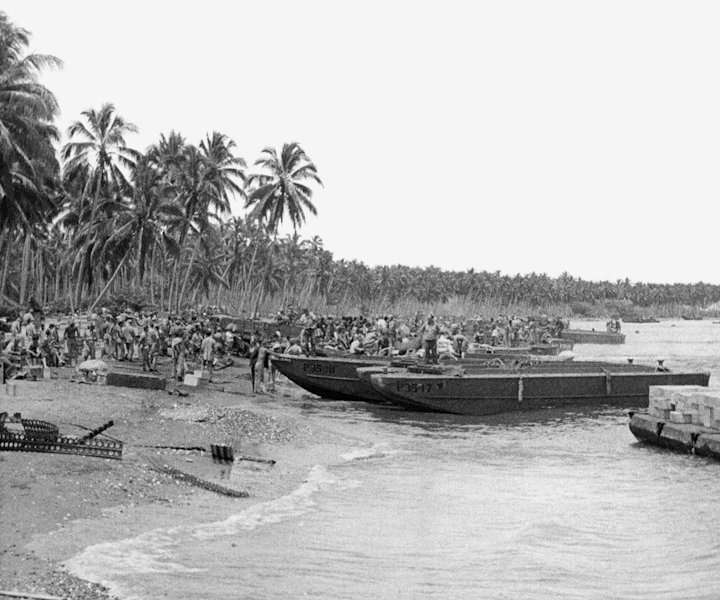
Patch then spent much of January 1943 probing the Japanese positions at Mount Austen, to the south of Henderson Field. The terrain there was extraordinarily rugged and the Japanese were heavily dug in, but soldiers of the Americal Division managed to seize a strategic point known as the Gifu. That deprived the Japanese of any viewpoint of Henderson Field and Lunga Point; they could no longer interfere with American activities on Guadalcanal.
Patch decided to encircle Mount Austen and starve the Japanese out -- which would not be too difficult, since they were dying of starvation at a rapid rate to begin with. By mid-January, however, the Japanese were already implementing their evacuation plan. On 23 January, they began pulling out of their positions on Mount Austen, moving back to Cape Esperance for withdrawal. They left behind a rearguard to make noise and keep the Americans in the dark about the withdrawal.
At the same time, Allied reconnaissance flights reported an accumulation of Japanese transports and warships at Rabaul and elsewhere in the region -- they were there to support the evacuation, but to US intelligence it appeared the Japanese were preparing another push, which was entirely believable because of the Japanese inclination to the offensive. Late in January, Japanese flying boats also performed a handful of night raids on Espiritu Santo, which proved harmless but reinforced the appearance of aggressiveness. Patch had cause, however misleading it was, to be cautious.
Energetic actions in such terrain were, once again, problematic in any case. Pursuit of an enemy, or for that matter the ability to sensibly determine an enemy's dispositions and intent, was extremely difficult. It wasn't easy for the Americans to know what they were up against, and it was troublesome to get supplies to the troops to keep them fighting. The Americans had to rely heavily on native porters, the troops nicknaming the porters the "Cannibal Battalion" -- apparently some mules were brought in as well, though the record is more obscure on that detail. Digging out the Japanese was very painful; their resolve could be a weakness on the offensive, encouraging them to perform rash and expensive frontal attacks, but on the defensive it was hard to see they had any weaknesses at all.
* The Americans were also given pause by another bloodying at sea. In late January, a US Navy task force consisting of the heavy cruisers WICHITA, CHICAGO, and LOUISVILLE, accompanied by smaller warships -- but not escort carriers, those assigned to the group having proven too slow to keep up with it -- was in the area in support of a reinforcement convoy.
At twilight on 29 January, the task force was near Rennell Island, just south of Guadalcanal, when it was jumped by Japanese aircraft out of Munda, which initially decorated the seas around the American warships with float flares. Many of the sailors were puzzled by this fireworks display, but some guessed the truth, that the task force was being marked for air attack.
Japanese torpedo-bombers then hit the task force, many of the attackers being lost to American anti-aircraft fire, but they succeeded in holing the CHICAGO. The LOUISVILLE took the damaged cruiser under tow; the Japanese returned the next afternoon, with most of the attackers were shot down, but enough were able to drop torpedoes to send the CHICAGO to the bottom. The "Battle of Rennell Island" was the seventh and final major sea clash for the Americans, and another defeat, the Japanese having demonstrated tactical innovation and determination to press the attack. The loss of the CHICAGO was painful -- the cruiser having survived some of the nastiest sea fights around Guadalcanal, to end up being sunk in the end.
* However, even the loss of CHICAGO was only one step back on the much improved situation for the Allies. After nightfall on 29 January, the Royal New Zealand Navy corvettes KIWI and MOA, out of Tulagi, had engaged the IJN submarine I-1, which was on a supply run. The two little lightly-armed vessels lit into the bigger and more heavily armed submarine with enthusiasm, forcing it to the surface with depth charges, then firing on it with all they had -- the KIWI even ramming it three times. The I-1 ended up grounded on a reef, its inspection proving very profitable for Allied intelligence officers.
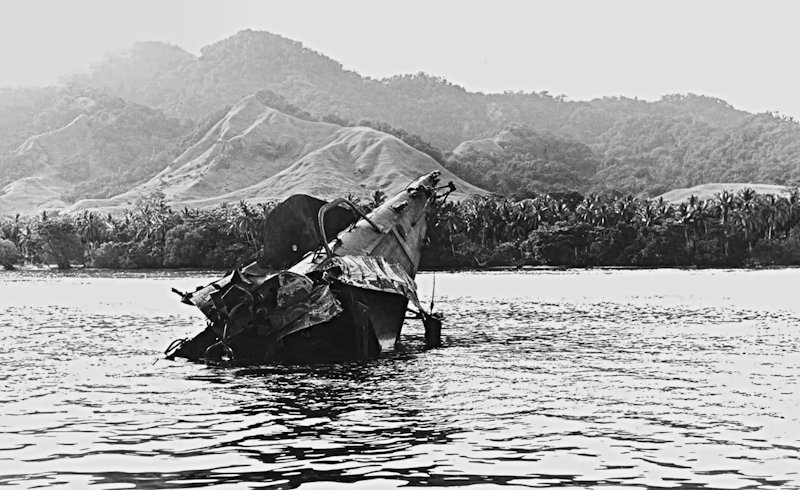
More significantly, the Allied reinforcement convoy delivered its loads without difficulty, as did another one a few days later. Patch now felt he was in a strong position to wipe out the IJA on Guadalcanal, not realizing that the Japanese were leaving quickly on their own initiative. The IJA had been withdrawing in small groups through much of January; on the evening of 1 February 1943, the first major evacuation column of 19 Japanese destroyers arrived off Cape Esperance. They had been attacked by American aircraft, but their fighter cover had driven them off. US Navy PT boats tried to interfere, but the Japanese sank three of them and sent the rest packing. That night, the Tokyo Express managed to evacuate over 5,400 starving Japanese soldiers.
A second column of destroyers showed up on the evening of 4 February, and managed to pull out almost 5,000 men. Only one destroyer was damaged. Much to the surprise of the Japanese, the third and final column of destroyers, which arrived on the evening of 5 February, managed to withdraw the remainder of the survivors, again with only one destroyer damaged. Later analyses would criticize Patch, with General Hyakutake expressing his relief at making a getaway -- but US ground force losses during this phase of the Guadalcanal campaign actually exceeded those of the defensive phase of 1942. If the casualties were any valid indication, Patch's troops had demonstrated their willingness to fight and his willingness to use them.
However it had happened, the Guadalcanal campaign was over. On 6 February, Patch sent a message to Halsey:
BEGIN_QUOTE:
TOTAL AND COMPLETE DEFEAT OF JAPANESE FORCES ON GUADALCANAL EFFECTED TODAY ... TOKYO EXPRESS NO LONGER HAS TERMINUS ON GUADALCANAL.
END_QUOTE
Aside from a few stragglers who would eventually die, be killed, or captured, the IJA was gone. The Japanese would show up for further air attacks, on occasion in strength, but given American air power on the island, the air attacks ended up being more expense than they were worth. Despite Patch's failure to move in for the kill, he did have good reason for satisfaction, Guadalcanal having proven, in the end, an unambiguous Japanese defeat. Total Japanese losses were estimated at over 30,000; total Allied losses at over 7,000, the bulk of them sailors lost in the brutal sea battles.
In the naval battle, the IJN had given as good as it got from the US Navy, the end tallies of warship losses and total tonnage being neatly balanced:
_____________________________________________________________________
ALLIES:
_____________________________________________________________________
2 carriers
HORNET WASP
6 heavy cruisers
ASTORIA CANBERRA CHICAGO NORTHAMPTON QUINCY VINCENNES
2 light cruisers
ATLANTA JUNEAU
14 destroyers
_____________________________________________________________________
IJN
_____________________________________________________________________
2 battleships
HIEI KIRISHIMA
1 light carrier
RYUUJOU
3 heavy cruisers
FURUTAKA KAKU KINUGASA
1 light cruiser
YURA
11 destroyers
6 submarines
_____________________________________________________________________
The fact that the Americans could make good their losses much more easily made an even trade an effective defeat for the Japanese; the IJN lost both vessels and, lacking much in the way of reserves, trained personnel they could not easily replace. As far as planes and pilots went, the war of attrition was even more painful to the Japanese -- Japanese naval air power going into gradual decline from that time on -- and on the ground, they had been given a thrashing. The 13,000 Japanese soldiers who were evacuated, many of them too used-up to ever be combat-capable again, were all that were left of 38,000 men the Japanese had funneled into Guadalcanal, which became known as the "Island of Death" to them. In comparison, the Americans had lost only about 1,600 men in the ground battles, though many more had to be evacuated due to illness.
The Japanese had been obsessed with the "decisive battle" with the Americans that would decide the fate of the war in the Pacific. To an extent, this was the exuberance of the Japanese military at work again, the inclination to dare all in a glorious to-the-death battle. Guadalcanal was nothing glorious, merely filthy, bloody, and diseased, but it was decisive all the same. From then on, the Japanese would be on the defensive, and there would be less and less doubt of the ultimate result of the war.
BACK_TO_TOP* This document started out as a short outline of the Guadalcanal campaign. Like many of my projects, although I did not wish to become too detailed, the work got out of hand and I ended up writing about twice as much as I had planned.
The Guadalcanal campaign is interesting because it consists of an interwoven series of land and sea battles over a period of about six months, making for a complicated and confusing narrative. The narrative is also interesting for its insights. The early phases of the battle have the odd sense of being a bloody comedy, where the arrogant Japanese consistently underestimated their Americans and failed to take adequate actions to deal with them; while the Americans came close to simply giving away the campaign through their own overconfidence, bumbling, timidity, and indecision. It might be said that the Americans won the Guadalcanal campaign simply because they made fewer blunders than the Japanese. Such is warfare.
However, in a broader sense, the Americans demonstrated a clear grasp of the art of war. The Japanese were not being entirely complacent in assuming that the Americans would not take the offensive against them until well into 1943; American war plans didn't envision reaching full mobilization for war until then, and there were senior officers in the American high command who doubted the feasibility of seriously striking back against Japan before America was in a solid position to do so -- all the more so, because US strategy was focused on fighting the war in Europe. The US was pushed into action by aggressive leaders like MacArthur and King, who wanted to hit the Japanese as fast as they could. Neither the US Navy nor the Marines were really ready to take the offensive in August 1942, and their preparations and training were inadequate. Despite all that, they took the initiative and, despite painful reverses, held on to it to the end of the campaign. This decisiveness more than compensated for all the bumbling.
In combat, the Americans received a brutal education from the Japanese, but it is hard to believe that if the Americans had delayed, they would not have suffered worse at the hands of an enemy that had been given more time to dig in. To the Japanese, Guadalcanal was the beginning of the end of the delusions that infected so many of their high command, particularly in the IJA. Despite extraordinary fighting spirit, the Japanese hadn't the resources to deal with the Americans over the long run, and no matter how great the fighting spirit of the Japanese soldiers, sailors, and fliers, it couldn't compensate for the failings of their leaders.
Tanaka Raizou commented in an article published in 1956 that the Japanese never formulated a comprehensive plan for the campaign, committed forces piecemeal, and never attained air superiority. He added that communications were "terrible"; relations between the IJA and IJN were "unendurable"; and that Japanese officers failed to outgrow their habit of belittling the enemy's capabilities, even as the Americans became by steps more dangerous. Tanaka concluded: "We stumbled along from one error to another, while the enemy grew wise."
* This document has used Romanized Japanese names, and the conventions used can be confusing to those unfamiliar with the culture and language. One of the first items is that, in reverse of the Western tradition, as is common among Asian culture a person's name is given with the family name first, the given name last. What makes this particularly confusing is that traditionally there has been a tendency to switch the order in English text to family name last, though proper arrangement is becoming more common. The family name is put first in this text -- Yamamoto Isoroku's family name was "Yamamoto" and his given name was "Isoroku". The given name means "fifty-six", by the way, that being the age of his father at the admiral's birth; to add to the confusion, in modern Japanese the name would be "Gojuuroku", "iso" being an archaic alternate word for "fifty".
As far as pronunciation goes, Japanese is not all that difficult for an English-speaker to pronounce, at least to the extent of making oneself understood. One obvious feature of Japanese is there is no "v" sound -- they substitute "b" instead -- and their "r" sound is "soft", actually somewhere in between an "r" and an "l". That's why "violin" transcribed into Japanese ends up being rendered as "baiorin".
More significantly for reading the Japanese names are the concepts of "double consonants" and "double vowels". A doubled consonant is straightforward, it just implies uttering a consonant twice -- for example "chotto matte (wait a bit)" is not spoken as "choh-toh mah-teh", it is spoken as "choht-to maht-te".
English speakers can adjust to this easily enough, but doubled vowels are trickier. It's actually the same idea as doubled consonants -- the sound is spoken twice. For example, "oji-san (uncle) is spoken "oh-jee-san", while "ojii-san (grandfather) is spoken "oh-jee-ee-san". Although English texts tend to drop doubled vowels, the difference is not slight -- "oji-san" and "ojii-san" are entirely different words. Anyway, "onee-san (older sister)" is pronounced "oh-neh-eh-san", while "juu (ten)" is pronounced "jew-ew". Where it gets tricky is with the "double o" -- "Satoo" for example. The instinct is to say "Saw-two", but it's actually pronounced "Saw-toh-oh", and so by convention it's rendered as "Satou" here. Incidentally, "Tokyo" is actually pronounced "Toukyou", but since "Tokyo" is the normal usage in English, that's kept here.
* Sources include:
* Illustration credits:
* Revision history:
v1.0 / 01 aug 99 v1.0.1 / 01 may 02 / Review & polish. v1.0.2 / 01 may 04 / Review & polish. v1.0.3 / 01 apr 06 / Review & polish. v1.0.4 / 01 apr 07 / Review & polish. v1.0.5 / 01 apr 09 / Review & polish. v1.0.6 / 01 oct 10 / Review & polish. v2.0.0 / 01 may 13 / Substantial rewrites, go to five chapters. v2.1.0 / 01 apr 15 / Considerable cleanup. v2.1.1 / 01 mar 17 / Review & polish. v2.1.2 / 01 feb 19 / Review & polish. v2.1.3 / 01 jan 21 / Review & polish. v2.1.4 / 01 nov 21 / Review & polish. v2.2.0 / 01 jul 24 / Illustrations update.BACK_TO_TOP
